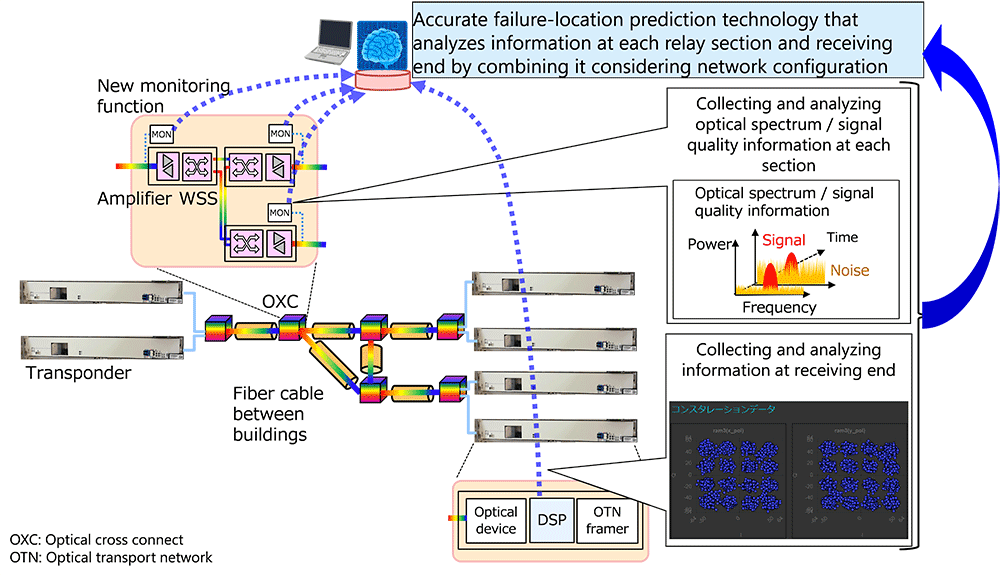Microsoft ends support for Internet Explorer on June 16, 2022.
We recommend using one of the browsers listed below.
- Microsoft Edge(Latest version)
- Mozilla Firefox(Latest version)
- Google Chrome(Latest version)
- Apple Safari(Latest version)
Please contact your browser provider for download and installation instructions.
July 21, 2022
Nippon Telegraph and Telephone Corporation
NTT demonstrated failure-location prediction for high-capacity optical transport network toward IOWN APN
- Aim for no service disruption by conducting preventive actions with high-accuracy failure-location prediction -
Nippon Telegraph and Telephone Corporation (head office: Chiyoda-ku, Tokyo; President and Chief Executive Officer: Akira Shimada; hereafter referred to as "NTT") has demonstrated the world's first technology of failure-location prediction for several failure modes in package granularity in a field environment using laid optical fiber cables and optical transport equipment that is combined with new functions.
Toward IOWN APN*1 realization, high-capacity optical transport equipment cannot avoid an increase in failure impact as the capacity increases. Therefore, we have been studying and demonstrated technology to locate a package predicted to have a failure on the basis of failure signs before service is affected by collecting and analyzing fine-grained optical signal characteristics. Predictive maintenance using the technology enables new maintenance and operation that can prevent failures from disrupting service and increase the efficiency and quality of the failure handling process. In addition, increasing optical transport network operability by using the technology can contribute to promoting IOWN APN deployment.
1. Background
Communication traffic will increase drastically because of the progress of the Internet of Things (IoT) and digital transformation and rapid expansion of remote activity. Therefore, traffic needs to be accommodated in a cost- and power-effective way.
As one cost- and power-effective way, NTT has been studying how to expand the capacity of optical transmission to more than 400G-bit/s per wavelength, but failure impact will also increase as the capacity increases. Thus, we have been studying a way to minimize the failure impact and increase reliability on optical transport networks.
In addition, for ease of adding new functions and flexibility on optical transport networks, multi-vendor disaggregation configuration has been studied. A multi-vendor disaggregation configuration enables optical direct connection among various optical transport systems from various venders. However, the complexity of the failure-location process is a concern because interwork of monitoring and control among various systems is limited and monitoring information at the direct connection point decreases.
2. Research outcomes
NTT has succeeded in locating a package of optical transport equipment predicted to have a failure on the basis of failure signs before service is affected by collecting and analyzing fine-grained optical signal characteristics.
This experiment was conducted in an environment using laid optical fiber cables and optical transport equipment that is combined with functions simulating package failure signs and new functions for monitoring and analyzing optical signal characteristics (Fig. 1). In the experiment, we demonstrated that failure package location could be predicted even in an actual operating environment and actual optical transport equipment behavior.
 Fig. 1 Field trial experimental configuration
Fig. 1 Field trial experimental configuration
The technology collects not only optical signal characteristics from DSP*3 at the receiving end of the optical path but also optical spectrum information*4 and OSNR*5 at each relay section. It then analyzes them considering collected points and network configuration to achieve fine-grained failure location prediction (Fig. 2). By using the technology, we can detect optical signal characteristic fluctuations as failure signs that cannot be detected by using only performance monitoring information*6 collected from the existing equipment. We then confirmed that the package with failure signs could be located.
 Fig. 2 Overview of technology collecting and analyzing optical signal characteristics
Fig. 2 Overview of technology collecting and analyzing optical signal characteristics
In addition, the experimental environment contained some transponders made by a vender different from that which made the relay equipment as the multi-vendor disaggregation configuration. We also confirmed that packages with failure signs could be located even with the limitation of interwork between the transponders and the relay equipment by analyzing optical characteristics themselves.
3. Future prospects
We are aiming to achieve more reliable high-capacity communication infrastructure by researching and developing technology for predicting failure location along with that for increasing the capacity.
In addition, we will use the technology to promote IOWN APN deployment that achieves drastic power saving and low latency by increasing operability and maintainability for optical transport networks.
Glossary
*1IOWN APN (Innovative Optical & Wireless Network All Photonics Network)
IOWN is a concept of network and information-processing infrastructure proposed by NTT, and APN is an innovative network based on photonics technology that is the foundation of IOWN.
https://www.rd.ntt/e/iown/
*2Multi-vendor disaggregation configuration
Optical transport equipment configuration that can assembly functions from multiple vendors flexibly. Conventionally all functions are provided by the same vendor.
*3DSP (Digital Signal Processor)
LSI for digital signal processing, important device in digital coherent communication systems.
*4Optical spectrum information
Optical signal expressed in terms of optical intensity relative to wavelength or optical frequency.
*5OSNR (Optical Signal-to-Noise Ratio)
Ratio of optical signal intensity to optical noise intensity. The lower the received OSNR, the greater the effect of optical noise and the lower the optical transmission quality.
*6Performance monitoring information
Information on optical signal characteristics and equipment status that can be periodically collected, stored, and read out from the optical transport equipment through the equipment's internal monitor.
Media Contact
NTT IOWN Integrated Innovation Center
Planning Department, Public Relations Section
nttrd-pr@ml.ntt.com
Information is current as of the date of issue of the individual press release.
Please be advised that information may be outdated after that point.
NTT STORY
WEB media that thinks about the future with NTT










